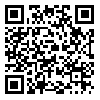Volume 13, Issue 2 (2025)
Health Educ Health Promot 2025, 13(2): 265-272 |
Back to browse issues page
Download citation:
BibTeX | RIS | EndNote | Medlars | ProCite | Reference Manager | RefWorks
Send citation to:



BibTeX | RIS | EndNote | Medlars | ProCite | Reference Manager | RefWorks
Send citation to:
Norouzi Aval R, Kimiafar K, Sarbaz M, Mousavi Baigi S. Awareness and Level of Digital Literacy among Paramedical Students. Health Educ Health Promot 2025; 13 (2) :265-272
URL: http://hehp.modares.ac.ir/article-5-80679-en.html
URL: http://hehp.modares.ac.ir/article-5-80679-en.html
1- “Department of Health Information Technology, Faculty of Paramedical and Rehabilitation Sciences” and “Student Research Committee”, Mashhad University of Medical Sciences, Mashhad, Iran
2- Department of Health Information Technology, Faculty of Paramedical and Rehabilitation Sciences, Mashhad University of Medical Sciences, Mashhad, Iran
2- Department of Health Information Technology, Faculty of Paramedical and Rehabilitation Sciences, Mashhad University of Medical Sciences, Mashhad, Iran
Abstract: (293 Views)
Aims: Digital literacy is a set of skills that enables individuals to effectively use digital technologies for learning, communication, and knowledge creation. Therefore, the aim of this study was to investigate the level of awareness and digital literacy among paramedical students.
Instrument & Methods: This cross-sectional study on students enrolled in the School of Paramedical Sciences and Rehabilitation at Mashhad University of Medical Sciences during the 2024 academic year was conducted from October 2024 to February 2025. Data were collected using a previously developed questionnaire by Aydınlar et al. in 2024. This questionnaire consisted of 31 questions and focused on topics, including demographic data, familiarity with programming, opinions on digital literacy, software, hardware, networks, ethics, security, artificial intelligence, and knowledge interest. The face validity of the questionnaire was assessed by faculty members, and its reliability was measured using the test-retest method. SPSS 26 software was used to analyze the data.
Findings: A total of 105 students responded to the survey. Sixty percent of the students were female, and 40% were male. Overall, more than half of the participants (51.4%) believed that digital literacy training was necessary but optional. In contrast, 30.5% stated that digital literacy training was necessary and mandatory. The domains of “interest-knowledge, artificial intelligence, network, ethics, and hardware” had the highest average scores, while the domains of “software and security” had the lowest averages. When examining the relationship between digital literacy domains and gender, the scores of men in the domain of “software and multimedia” were significantly higher than those of women (p-value=0.021).
Conclusion: There are both strengths and gaps in digital literacy among paramedical students and they have moderate to high competency in several key areas, particularly in artificial intelligence awareness, networking, hardware, and ethical considerations.
Instrument & Methods: This cross-sectional study on students enrolled in the School of Paramedical Sciences and Rehabilitation at Mashhad University of Medical Sciences during the 2024 academic year was conducted from October 2024 to February 2025. Data were collected using a previously developed questionnaire by Aydınlar et al. in 2024. This questionnaire consisted of 31 questions and focused on topics, including demographic data, familiarity with programming, opinions on digital literacy, software, hardware, networks, ethics, security, artificial intelligence, and knowledge interest. The face validity of the questionnaire was assessed by faculty members, and its reliability was measured using the test-retest method. SPSS 26 software was used to analyze the data.
Findings: A total of 105 students responded to the survey. Sixty percent of the students were female, and 40% were male. Overall, more than half of the participants (51.4%) believed that digital literacy training was necessary but optional. In contrast, 30.5% stated that digital literacy training was necessary and mandatory. The domains of “interest-knowledge, artificial intelligence, network, ethics, and hardware” had the highest average scores, while the domains of “software and security” had the lowest averages. When examining the relationship between digital literacy domains and gender, the scores of men in the domain of “software and multimedia” were significantly higher than those of women (p-value=0.021).
Conclusion: There are both strengths and gaps in digital literacy among paramedical students and they have moderate to high competency in several key areas, particularly in artificial intelligence awareness, networking, hardware, and ethical considerations.
Article Type: Descriptive & Survey |
Subject:
Technology of Health Education
Received: 2025/05/3 | Accepted: 2025/06/14 | Published: 2025/06/18
Received: 2025/05/3 | Accepted: 2025/06/14 | Published: 2025/06/18
| Rights and permissions | |
 |
This work is licensed under a Creative Commons Attribution-NonCommercial 4.0 International License. |






